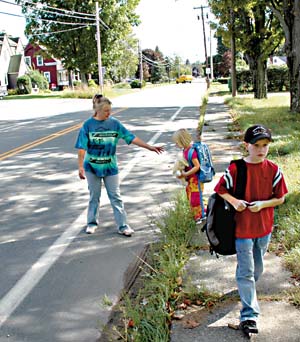
|
Dan Hust | Democrat
JEFFERSONVILLE MOTHER KIM Breihof escorts her daughter Triniti, 5, and son Eric, 10, up Route 52 from the bus stop to the family’s home. Breihof and Sullivan West school administrators are at odds about the safety of the road.
|
Dispute Over Bus Stop Gearing Up at Sullivan West
By Dan Hust
JEFFERSONVILLE — September 18, 2007 — Kim Breihof’s dilemma is emblematic of a school district’s most common headache.
The Jeffersonville resident is wrestling with the Sullivan West Central School District over her kids’ bus stop.
For the past eight years, it’s been in front of her and husband Eric’s Route 52 home. But this year, as part of a typical shifting of bus stops that happens in every school district, it was moved about eight houses down Route 52 to its intersection with Creekside Drive in Kohlertown.
For about half that distance, a sidewalk runs along the west side of 52, which here is a flat, straight stretch where many drivers routinely exceed the 35 MPH speed limit.
Breihof considers the walk unsafe and hasn’t let her four children – Gina, 13, Eric, 10, Darian, 6 and Triniti, 5 – walk to or from the bus stop in bad weather or dark conditions.
She’s able right now to drive her children to the nearby elementary school and the high school in Lake Huntington, but she soon hopes to have a job as a substitute nurse at SW.
With her husband a full-time Sullivan County Sheriff’s deputy and winter approaching with the promise of snow and early darkness, Breihof will be faced with some difficult choices.
“Don’t get me wrong: I think walking to and from a bus stop is good for a kid,” she explained. “But walking to and from a dangerous stop is not good for any kid. I don’t want my kids to become a statistic.”
Neither do district officials, but they’ve taken a different stance than Breihof.
“We cluster stops based on where kids live,” explained Superintendent Kenneth Hilton, adding that if every one of SW’s 1,500 students received door-to-door service, “we would spend a lot more money and have a lot longer runs.”
SW is bound by its board-adopted policy, which requires most trips to be under an hour and allows stops to be located as much as five-tenths of a mile from an elementary student’s home and a mile from a high-schooler’s.
Hilton acknowledged that this Thursday’s regular school board meeting will include a discussion of a special transportation arrangement called a Child Safety Zone, but it will be for a family near Hancock, not for Breihof or the two other parents who formally complained to the district this year.
He, Assistant Supt. for Business Larry Lawrence and School Business Manager Lorraine Poston personally visited the Kohlertown stop, and all came to the same conclusion:
It’s safe.
“Almost all of [Route 52 in that location] has a sidewalk,” Hilton noted.
In fact, Lawrence sent a letter to Breihof informing her that the district was legally within its rights to change bus stops to better serve all students.
“In essence, it was saying I wasn’t going to win,” complained Breihof.
So in concert with about half a dozen other concerned parents, she wrote a petition and so far has gathered 200 signatures on it from across the 200-square-mile district.
Undersheriff Eric Chaboty plans to write a letter on the family’s behalf, telling the district it would be far safer to return the bus stop to the Breihofs’ home, due in no small part to the high volume of traffic.
“It’s common sense,” said Chaboty. “Small kids should not be walking any distance on that road.”
“I think it’s just stupid,” agreed Breihof’s 10-year-old son, Eric. “There’s going to be an accident soon. They drive fast, and people are going to have to walk on the road when it snows.”
Hilton said he’s sympathetic, but he disagrees about the perceived safety issues.
“Heck, we have kids. We are parents,” he said.
He also pointed out that SW spends upwards of $1,300 per student on transportation alone, nearly twice as much as his former employer, the Henrietta-Rush district near Rochester, spent on each of its 6,000 students.
But in the end, it’s the board that can make or break policy, and a discussion on Breihof’s and others’ concerns will likely be part of Thursday’s discussion.
Breihof hopes it will turn into action.
“We know they may really feel this is safe, but we expect more from our district,” she said. “… We’re asking them in good faith to take a look at what they’ve done.”
|

